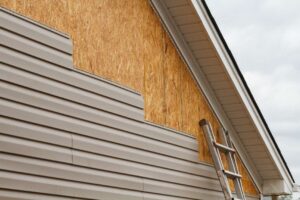Stucco Charleston SC is an important part of your home, protecting it from moisture and other elements. It is also an attractive way to dress up your home’s exterior.
Before siding installation, it’s a good idea to trim branches and move any furniture that might be in the way. Some contractors will do this for you, but it’s also your responsibility to create room for the crew to work.

Before beginning your siding installation, the contractors will powerwash all exterior walls. This will remove any dirt and debris that might interfere with the new siding. They’ll also inspect the existing wall for water rot, sheathing damages, and asbestos. Before the project, the contractor will address these issues to ensure the new siding is securely attached and durable.
After the wall is cleaned and prepped, the construction crew will begin stripping the old siding down to your home’s frame. Then, they will install a base layer known as substrate, made of oriented-strand boarding (OSB) and similar to plywood. Next, a weather barrier will be stapled over the substrate to add another layer of protection from moisture for your home’s interior.
If you have bushes or trees near your house, trim them back to minimize the risk of them getting scraped during the process. It’s also a good idea to move any lawn decorations, furniture, or gardening equipment that might be in the path of the construction site. This will make the job more efficient and safer for the crew. The contractor will also remove and dispose of any old debris from the work area, so you won’t have to worry about it being left around your property or driveway.
In the meantime, it’s a good idea to park your vehicles farther away from your house to free up space for the dumpster and for workers to access your vehicle for materials. It’s also a good idea for families with children and pets to stay inside during the installation to avoid disturbing them by commotion.
Once the siding is installed, your contractor will reinstall any shutters and downspouts you removed during prep. They’ll also apply caulking around all edges of the new siding to secure it and help it resist moisture. They’ll use Sherwin Williams Duration caulking, which has a 50-year lifetime and will protect your siding from fading, chipping, or cracking over time.
When installing siding, it is important to have the right materials. The right materials will ensure a durable, long-lasting result. Different types of siding are available, from traditional wood-look products to engineered wood strand materials. Engineered wood strand technology allows these products to retain the look of real wood while being more resilient and long-lasting. These materials are often treated with zinc borate and other chemicals to protect against fungal decay, termites, and moisture.
The siding should be installed over a continuous water-resistive barrier to stop the intrusion of incidental rainfall. Check with your local building code to determine what type of barrier is required in your geographic area. Code-compliant flashing should be integrated with the water-resistive barrier and applied at the intersection of walls and roofing to prevent water infiltration (Fig. 26).
To help prevent water infiltration, it is best to install the trim and flashing before the siding is installed. This helps to give the siding a tighter fit around these areas and reduces the amount of caulk needed afterward.
Before installing the siding, the trim and flashing should be nailed with a trim nailer. The nails used should be finishing nails, not coil nails, as they are smaller and have a smooth head that is less likely to damage the siding. These nails can be purchased from most home improvement stores.
After the trim and flashing are in place, a type of flashing called Z-flashing should be installed above all doors and windows. This flashing is shaped like a long Z and is installed with one edge against the frame of the window or door and the other hanging slightly over the trim to redirect any water behind the rim.
Once the flashing and trim are in place, the substrate can be installed. A popular material for the substrate is oriented-strand boarding, or OSB, which is similar to plywood and provides extra stability for the vinyl siding. Some siding manufacturers also offer an insulated substrate product that can help increase your home’s energy efficiency.
If you are a DIYer or hiring a contractor, gathering materials and tools is one of the first steps. This includes a tape measure, pen/pencil and paper, a ladder, and possibly a rough sketch of the house. Once everything is ready, the siding installation begins. It is a good idea to start with the longest wall on the home’s exterior to get into a rhythm and ensure you are measuring correctly. All houses can be broken down into shapes of triangles and rectangles, which will help with the measurements. It would be best to determine where the soffit will be, as the new siding needs to meet with the house.
Once all the wall areas are measured, you can calculate how many squares of siding you will need for your project. For rectangular walls, you will need to take the area of each wall minus any windows and doors. For roofs, you will need to measure the base and height of each roof. You can also add the area of any garages, sheds, or other triangular structures on your property. It is a good idea to add 10% of the material in case of any waste or errors during the process. This will ensure you have enough materials during the siding installation.
The siding can be placed after the substrate (OSB, plywood, or similar product) is installed, and a weather barrier is stapled. Using a joint tape between the substrate and the weather barrier is important to prevent moisture from entering your home’s frame.
The last step of the siding installation is to nail the pieces together. Several methods can be used, but the most common is to use 3D-painted nails with colored heads that match the color of your siding. This allows for expansion and contraction while still allowing for a tight fit.
At this point, any other elements that need to be reinstalled, such as trim and window and door trim, can be reattached. This can also be a good time to reinstall any shutters. Once everything is in place, the yard will be cleaned, and any old materials removed during the siding installation will be released for recycling.
A proper maintenance plan is the best way to ensure that your siding lasts long. Developing one includes scheduling routine cleaning and inspections, identifying and making necessary repairs, and budgeting for major replacements or repair services. Regular inspections should consist of checking for signs of weather damage, including dents or cracks in the siding, loose boards, and water leaks. If you notice any problems, contact a professional siding contractor immediately to prevent further damage or mold growth.
It is also important to check that your gutters are blockage-free to prevent overflow and flooding of the sheathing, which can promote mold and mildew. It would be best to trim overhanging branches and foliage, as they can scratch or catch on the siding and cause damage. If your siding is exposed to a lot of rain, you should also consider re-nailing loose sheathing or replacing rotting components.
If you have steel siding, regularly inspect it after a storm to ensure that wind or flying debris doesn’t leave marks that could eventually rust. If you spot any scratches, apply a nonabrasive stainless steel scratch remover and scrub with a wire brush. If rust does appear, use a rust-inhibitive primer and paint the affected area (Miceli and Heil).
Once all the sheathing is installed, it’s a good idea to caulk or seal any gaps or seams in your siding to keep moisture out. This will not only prevent moisture penetration and promote a more energy-efficient home, but it will help to maintain the beauty and durability of your new siding.
Sealing any openings around pipes, vents, electrical outlets, and windows is also a good idea. This will help to improve your home’s energy efficiency, prevent moisture infiltration, and reduce air and sound pollution.
